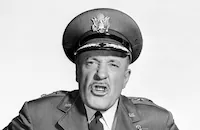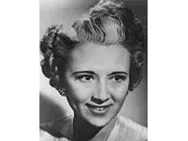Move Over, Darling

Brief Synopsis
Cast & Crew
Michael Gordon
Doris Day
James Garner
Polly Bergen
Chuck Connors
Thelma Ritter
Film Details
Technical Specs

Synopsis
Ellen Arden is rescued from a South Seas island and brought back to the United States 5 years after she disappeared in an airplane crash. On the same day, her husband, Nick, is in court to hear Judge Bryson declare Ellen legally dead. Nick then marries beautiful but dumb Bianca Steele, and they go to a resort hotel for their honeymoon.
Meanwhile, Ellen returns home and is distressed when her two children fail to recognize her. Learning from Nick's mother that he has just remarried, Ellen proceeds to the honeymoon hotel, where Nick immediately catches a glimpse of her. Still in love with Ellen, Nick feigns a back injury and returns home with Bianca. Ellen flies home and arrives ahead of the newlyweds, pretending to be Nick's masseuse. Nick learns that a man was also stranded with Ellen, but she describes him as small and unappealing. Unknown to Ellen, Nick goes to see this man, who is actually a handsome athlete, while Ellen hires a meek shoeclerk to impersonate him. Afterwards, Nick listens to the story told by Ellen and the shoeclerk but reveals that he knows the truth.
Enraged, Ellen rushes home, with Nick in pursuit. Bianca is there, and Nick confesses that Ellen is his wife as detectives enter to arrest him for bigamy, a charge brought by his mother. Judge Bryson annuls Nick and Bianca's marriage, but when Ellen's real island companion arrives to identify her so that she can be declared legally alive, she becomes flustered and Nick storms off in a jealous rage. Later, at home, Ellen is about to tell the children that she is their mother when she learns that Nick has already informed them.

Director
Michael Gordon
Cast

Doris Day

James Garner

Polly Bergen

Chuck Connors

Thelma Ritter

Fred Clark

Don Knotts
Elliott Reid

Edgar Buchanan
John Astin
Pat Harrington Jr.

Eddie Quillan
Max Showalter

Alvy Moore
Pami Lee
Leslie Farrell
Rosa Turich
Harold Goodwin
Alan Sues
Pat Moran

Bess Flowers
Rachel Romen
Jack Orrison
Kelton Garwood
Joel Collins
Sid Gould
Ed "skipper" Mcnally
James Patridge
Christopher Connelly

Billy Halop
Med Flory
Emile Meyer
Brad Trumbull
Michael Romanoff
John Harmon
Crew
L. B. Abbott
Warren Barker
Hilyard Brown
Jack Brown
Alfred Bruzlin
Glenn "skippy" Delfino
Margaret Donovan
Daniel L. Fapp
Walter Fitchman
Paul S. Fox
Gaston Glass
Hal Kanter
Hal Kanter
James Knott
Emil Kosa Jr.
Barbara Lampson
Joe Lubin
Moss Mabry
George Masters
Leo Mccarey
Martin Melcher
Terry Melcher
James Mitchell
Arthur Morton
Lionel Newman
Ben Nye
Marjorie Plecher
Elmer Raguse
Aaron Rosenberg
Dolores Rubin
Ad Schaumer
Walter M. Scott
Carl Shain
Jack Sher
Mickey Sherrard
Robert Simpson
Jack Martin Smith
Bella Spewack
Samuel Spewack

Photo Collections
Videos
Movie Clip





Trailer
Hosted Intro
Film Details
Technical Specs

Articles
Move Over, Darling
At the time Move Over, Darling was made, Day was married to Martin Melcher, who produced the film. And although the picture was very much in the vein of madcap romantic comedies Day had done previously - like the 1962 That Touch of Mink and the 1959 Pillow Talk (the latter of which, like Move Over, Darling, was directed by Michael Gordon), it was made at a point when Day was under the thumb of her husband, who would, in the course of the early to mid-1960s, drive her to the point of nervous exhaustion. Melcher had married Day in 1951, just a few years after the aspiring actress - who'd already embarked on a singing career - had begun her film career at Warner Bros. (Her first picture was the 1948 Romance on the High Seas, with Jack Carson and Janis Paige.) Day was one of those immediately likable performers whose career took off like a shot, and Melcher availed himself of plenty of the attendant financial benefits. Their marriage would last until his death, in 1968, but few would defend Melcher as the ideal husband - least of all Day's Move Over, Darling co-star.
James Garner is notoriously reticent about giving interviews. According to Raymond Strait's 1985 Garner biography, the star was quoted, around the time Move Over, Darling was being made, as saying, "I'm not a great windbag. In fact, being interviewed makes me feel funny. I absolutely hate publicity. . . . I'd rather dig a ditch than do an interview." But surprisingly enough - or maybe not - Garner's honesty has made him an invaluable, candid oral historian. In the 1976 A.E. Hotchner biography, Doris Day: Her Own Story, Garner doesn't mince words in expressing his feelings about Melcher: "Marty was a hustler, a shallow, insecure hustler who always ripped off fifty thousand dollars on every one of Doris's films as the price for making the deal." Although Melcher set himself up as executive producer on Day's films, he'd rarely show up on the set, and when he did, Garner would avoid him: "You don't get too close to a guy like that, just good morning, no conversation, and keep your hand on your wallet." He caps off the tirade with the kind of bold assessment nobody in today's Hollywood would ever dare to make: "I never knew anyone who liked Melcher."
If Garner is damning about Melcher, he has nothing but affection for Day, and the feelings seem to be mutual. As Day says in Garner's 2011 memoir The Garner Files, "Jim and I only worked together twice, in Move Over, Darling and The Thrill of It All [1963]. He's so good at what he does...I felt married." Garner goes even further - he's clearly the kind of actor who can acknowledge the sexual charge he feels with a fellow performer without turning it into something prurient or cheap. In Doris Day: Her Own Story, Garner says that of all the women he's played love scenes with, Day and Julie Andrews - both of them, he notes, "notorious girls next door" - were the sexiest. "Playing a love scene with either of them is duck soup because they communicate something sexy which means I also let myself go somewhat and that really makes a love scene work," Garner says. "You just can't do that with someone you don't like or who's a lump unless you're a hell of an actor and I'm not that good an actor." Garner also called Day "the Fred Astaire of comedy," meaning that she could switch acting partners effortlessly -- and she always made her partner look good.
In Move Over, Darling, especially, Day's gifts as a physical comedienne are on full display: Disguised as a Swedish nurse, she chases a semi-naked Polly Bergen around a bedroom; she tumbles into a pool with great gusto; she tussles with Garner in a way that suggests, but doesn't spell out, the frustrated sexual frisson between the two characters. Day, in her youth, had hoped to be a dancer, and although a car accident curtailed that dream, she could really move on-screen, nimbly and with a remarkably game spirit. She's the kind of performer who's up for anything, and not even a cracked rib or two could ever stop her. In Hotchner's book, Day explains that Garner, "a man of heft and muscle, picked me up under his arm a little too enthusiastically and cracked a couple of my ribs. I made that movie mummified with adhesive tape, which made it difficult to breathe and painful to laugh." And years later, Day - who has remained friends with Garner through the decades -- would still be able to laugh about the incident: In The Garner Files, she's quoted as saying, "Jim, if we don't speak for a while, I forgive you for breaking my ribs. Both of them. Don't give it another thought."
Producer: Martin Melcher, Aaron Rosenberg
Director: Michael Gordon
Screenplay: Hal Kanter, Jack Sher (screenplay); Leo McCarey (story); Bella Spewack, Samuel Spewack (1940 story and screenplay "My Favorite Wife")
Cinematography: Daniel L. Fapp
Art Direction: Hilyard Brown, Jack Martin Smith
Music: Lionel Newman
Film Editing: Robert Simpson
Cast: Doris Day (Ellen Wagstaff Arden), James Garner (Nicholas Arden), Polly Bergen (Bianca Steele), Thelma Ritter (Grace Arden), Fred Clark (Mr. Codd, hotel manager), Don Knotts (Shoe clerk), Elliott Reid (Dr. Herman Schlick), Edgar Buchanan (Judge Bryson), John Astin (Clyde Prokey), Pat Harrington, Jr. (District Attorney).
C-103m.
by Stephanie Zacharek (Stephanie is the chief movie critic for Movieline - www.movieline.com)
SOURCES:
James Garner with Jon Winoker, The Garner Files: A Memoir, Simon & Schuster, 2011
Raymond Strait, James Garner: A Biography, St. Martins Press, 1985
A.E. Hotchner, Doris Day: Her Own Story, Bantam Books, 1976

Move Over, Darling
Quotes
Trivia
A re-shot version of Something's Got to Give (1962), the film Marilyn Monroe was working on when she died.
The movie that Ellen describes to Bianca while giving her a massage is My Favorite Wife, of which Move Over Darling is a remake.
'Day, Doris' proved what a trouper she truly was when James Garner accidentally broke her rib (during the massage scene, when he pulls her off of Polly Bergen). Garner wasn't even aware of what had happened until the next day, when he felt the bandage while putting his arms around her.
The film's producers scheduled the scene with Doris Day riding through a car wash for the last day of shooting because they were concerned that the detergents used in the car wash might affect the star's complexion. When the scene went off without a hitch, they admitted their ploy to Day, then used the story in promotional materials for the film.
Notes
Remake of My Favorite Wife (R.K.O., 1940).

Miscellaneous Notes
Released in United States 1963
Remake of "My Favorite Wife" (1940) directed by Garson Kanin.
Marilyn Monroe was orginally slated to star in this with George Cukor directing and Dean Martin co-starring, but her death put the project into turnaround.
CinemaScope
Released in United States 1963















